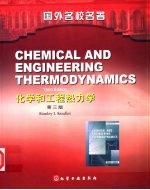图书介绍
化学和工程热力学 第3版 英文PDF|Epub|txt|kindle电子书版本网盘下载

- (美)桑德乐(Sandler,S.I.)著 著
- 出版社: 北京:化学工业出版社
- ISBN:7502528202
- 出版时间:2002
- 标注页数:772页
- 文件大小:56MB
- 文件页数:791页
- 主题词:理论化学
PDF下载
下载说明
化学和工程热力学 第3版 英文PDF格式电子书版下载
下载的文件为RAR压缩包。需要使用解压软件进行解压得到PDF格式图书。建议使用BT下载工具Free Download Manager进行下载,简称FDM(免费,没有广告,支持多平台)。本站资源全部打包为BT种子。所以需要使用专业的BT下载软件进行下载。如BitComet qBittorrent uTorrent等BT下载工具。迅雷目前由于本站不是热门资源。不推荐使用!后期资源热门了。安装了迅雷也可以迅雷进行下载!
(文件页数 要大于 标注页数,上中下等多册电子书除外)
注意:本站所有压缩包均有解压码: 点击下载压缩包解压工具
图书目录
CHAPTER 1 INTRODUCTION1
1.1 The Central Problems of Thermodynamics1
1.2 A System of Units3
1.3 The Equilibrium State5
1.4 Pressure,Temperature,and Equilibrium7
1.5 Heat,Work,and the Conservation of Energy12
1.6 Specification of the Equilibrium State;Intensive and Extensive Variables;Equations of State15
1.7 A Summary of Important Experimental Observations18
1.8 A Comment on the Development of Thermodynamics20
Problems20
CHAPTER 2 CONSERVATION OF MASS AND ENERGY22
2.1 A General Balance Equation and Conserved Quantities23
2.2 Conservation of Mass27
2.3 Conservation of Energy30
2.4 The Thermodynamic Properties of Matter43
2.5 Applications of the Mass and Energy Balances51
2.6 Conservation of Momentum75
2.7 The Microscopic Equations of Change for Thermodynamics and Fluid Mechanics(Optional)76
Problems82
CHAPTER 3 ENTROPY:AN ADDITIONAL BALANCE EQUATION89
3.1 Entropy:A New Concept90
3.2 The Entropy Balance and Reversibility97
3.3 Heat,Work,Engines,and Entropy103
3.4 Entropy Changes of Matter112
3.5 Applications of the Entropy Balance115
3.6 Liquefaction128
3.7 Power Generation and Refrigeration Cycles132
3.8 The Thermodynamics of Mechanical Explosions154
3.9 The Microscopic Entropy Balance(Optional)163
Problems165
4.1 Some Mathematical Preliminaries175
CHAPTER 4 THE THERMODYNAMIC PROPERTIES OF REAL SUBSTANCES175
4.2 The Evaluation of Thermodynamic Partial Derivatives179
4.3 The Ideal Gas and Absolute-Temperature Scales194
4.4 The Evaluation of Changes in the Thermodynamic Properties of Real Substances Accompanying a Change of State195
4.5 An Example Involving the Change of State of a Real Gas219
4.6 The Principle of Corresponding States225
4.7 Generalized Equations of State238
4.8 The Third Law of Thermodynamics242
4.9 More About Thermodynamic Partial Derivatives(Optional)243
Appendix A4.1 A Program for Thermodynamic Properties Calculations Using the Peng-Robinson Cubic Equation of State,PR1249
Problems251
CHAPTER 5 EQUILIBRIUM AND STABILITY IN ONE-COMPONENT SYSTEMS260
5.1 The Criteria for Equilibrium260
5.2 Stability of Thermodynamic Systems265
5.3 Phase Equilibria:Application of the Equilibrium and Stability Criteria to the Equation of State272
5.4 The Molar Gibbs Free Energy and Fugacity of a Pure Component279
5.5 The Calculation of Pure Fluid-Phase Equilibrium:The Computation of Vapor Pressure from an Equation of State295
5.6 The Specification of the Equilibrium Thermodynamic State of a System of Several Phases:The Gibbs Phase Rule for a One-Component System303
5.7 Thermodynamic Properties of Phase Transitions307
Problems313
CHAPTER 6 THE THERMODYNAMICS OF MULTICOMPONENT MIXTURES324
6.1 The Thermodynamic Description of Mixtures324
6.2 The Partial Molar Gibbs Free Energy and the Generalized Gibbs-Duhem Equation333
6.3 A Notation for Chemical Reactions337
6.4 The Equations of Change for a Multicomponent System340
6.5 The Heat of Reaction and a Convention for the Thermodynamic Properties of Reacting Mixtures349
6.6 The Experimental Determination of the Partial Molar Volume and Enthalpy354
6.7 Criteria for Phase Equilibrium in Multicomponent Systems364
6.8 The Criteria for Chemical Equilibrium,and Combined Chemical and Phase Equilibrium368
6.9 The Specification of the Equilibrium Thermodynamic State of a Multicomponent,Multiphase System;the Gibbs Phase Rule373
Problems377
6.10 Some Concluding Remarks377
CHAPTER 7 THE ESTIMATION OF THE GIBBS FREE ENERGY AND FUGACITY OF A COMPONENT IN A MIXTURE388
7.1 The Ideal Gas Mixture388
7.2 The Partial Molar Gibbs Free Energy and Fugacity392
7.3 The Ideal Mixture and Excess Mixture Properties396
7.4 The Fugacity of Species in Gaseous,Liquid,and Solid Mixtures406
7.5 Several Correlative Liquid Mixture(Activity Coefficient)Models414
7.6 Two Predictive Activity Coefficient Models428
7.7 A Corresponding States Principle for Mixtures;The Pseudocritical Constant Method437
7.8 The Fugacity of Species in Nonsimple Mixtures444
7.9 Some Comments on Reference and Standard States451
7.10 A Combined Equation-of-State—Excess Gibbs Free Energy Models452
7.11 Electrolyte Solutions455
7.12 Concluding Remarks461
Appendix A7.1 A Statistical Mechanical Interpretation of the Entropy of Mixing in an Ideal Mixture464
Appendix A7.2 A Program for Multicomponent Vapor-Liquid Equilibrium Calculations Using the Peng-Robinson Cubic Equation of State,VLMU467
Appendix A7.3 Multicomponent Excess Gibbs Free Energy(Activity Coefficient)Models468
Appendix A7.4 A Program for the Prediction of Activity Coefficients and Low Pressure Vapor-Liquid Equilibrium Using the UNIFAC Model,UNIFAC.470
Problems471
CHAPTER 8 PHASE EQUILIBRIUM IN MIXTURES478
8.1 Vapor-Liquid Equilibria Using Activity Coefficient Models478
Problems for Section 8.1511
8.2 Vapor-Liquid Equilibria Using Equations of State518
Problems for Section 8.2534
8.3 The Solubility of a Gas in a Liquid536
Problems for Section 8.3547
8.4 The Solubility of a Liquid in a Liquid and Vapor-Liquid-Liquid Equilibrium550
Problems for Section 8.4571
8.5 The Solubility of a Solid in a Liquid,Gas,or Supercritical Fluid575
Problems for Section 8.5585
8.6 The Partitioning of a Solute Among Two Coexisting Liquid Phases;The Distribution Coefficient586
Problems for Section 8.6597
8.7 Freezing-Point Depression of a Solvent Due to the Presence of a Solute;the Freezing Point of Liquid Mixtures598
Problems for Section 8.7602
8.8 Osmotic Equilibrium and Osmotic Pressure603
Problems for Section 8.8606
8.9 The Phase Behavior Modeling of Chemicals in the Environment608
Problems for Section 8.9613
8.10 The Phase Behavior of Solid Mixtures614
Problems for Section 8.10622
8.11 Concluding Remarks623
Additional Phase Equilibrium Problems624
CHAPTER 9 CHEMICAL EQUILIBRIUM AND THE BALANCE EQUATIONS FOR CHEMICALLY REACTING SYSTEMS630
9.1 Chemical Equilibrium in a Single-Phase System630
9.2 Heterogeneous Chemical Reactions663
9.3 Chemical Equilibrium When Several Reactions Occur in a Single Phase676
9.4 Combined Chemical and Phase Equilibrium683
9.5 The Balance Equations for a Tank-Type Chemical Reactor691
9.6 The Balance Equations for a Tubular Reactor699
9.7 Overall Reactor Balance Equations and the Adiabatic Reaction Temperature702
9.8 The Thermodynamics of Chemical Explosions711
9.9 Introduction to Electrochemical Processes717
9.10 Coupled Chemical Reactions727
Appendix A9.1 A Program for the Calculation of Chemical Equilibrium Constants As a Function of Temperature,CHEMEQ730
Problems731
APPENDIXES744
Appendix Ⅰ Conversion Factors for SI Units744
Appendix Ⅱ The Molar Heat Capacities of Gases in the Ideal Gas(Zero Pressure)State745
Appendix Ⅲ The Thermodynamic Properties of Water and Steam748
Appendix Ⅳ Enthalpies and Free Energies of Formation758
Appendix Ⅴ Heats of Combustion761
INDEX763